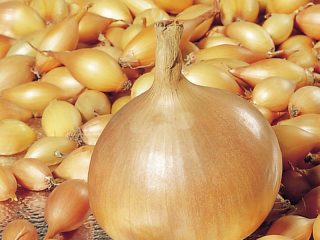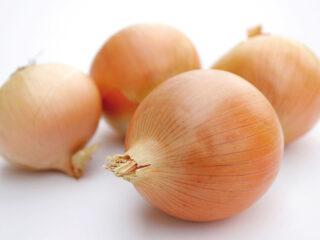Content
Planting onions in the fall before winter in the Urals allows you to reduce spring work and ensure an early harvest of this crop. For planting onions in this region, frost-resistant varieties that can tolerate harsh winters.
Advantages and disadvantages of winter planting
Autumn planting of onions has the following advantages:
- It is quite difficult to preserve planting material until spring, especially small ones;
- planting work in spring is reduced;
- getting an early harvest;
- the opportunity in summer to use the beds freed from winter onions, under greens or early ripening vegetables;
- Winter crops are weeded less often, since the first shoots appear immediately after the snow, and the onion has time to grow before active spread weed;
- obtaining large-sized bulbs;
- Until mid-May, the soil in which moisture remains for a long time is not watered.
Planting onions before winter has its disadvantages:
- lower yield than when planting bulbs in spring;
- There may be difficulties with storing the crop.
The decrease in winter onion yields is due to the fact that some bulbs cannot withstand cold conditions. With temperature changes, high humidity and winter frosts, the crop may die.Therefore, you need to be especially careful To choosing onion varieties for planting in winter.
Variety selection
For planting in the Urals, frost-resistant varieties of onions are chosen that can withstand a significant drop in temperature. This includes hybrid varieties whose bulbs are capable of developing under short and medium daylight hours. Seed material is divided into three groups:
- wild oat with bulb sizes less than 1 cm;
- sets with sizes from 1 to 3 cm;
- selection with larger bulbs.
When sowing a selection, you can get abundant greenery in the spring, but you shouldn’t count on large bulbs. If you want to get onions, then choose sets. The wild oat produces small bulbs and feathers in the spring. In winter, the following onion varieties are planted in the Urals:
- Shakespeare. One of the most common varieties suitable for portable planting. Its bulbs are large in size and round in shape. Due to the dense husk, the variety is able to withstand low temperatures. Shakespeare onions ripen in 75 days.
- Radar. Another good winter variety that has excellent taste. Due to its high germination rate, Radar produces a large harvest.
- Ellan. A short-day variety with round-shaped bulbs, golden husks and a sweetish taste. The harvest is already in June.
- Sturon. It is distinguished by elliptical-shaped bulbs that ripen in three months. This onion can be stored for 8 months.
- Senshui. Early ripening variety, resistant to low temperatures. The bulbs rarely form shoots and are stored for a long time after harvesting.
- Red Baron. A mid-early red onion variety, unpretentious to climatic conditions. It has a pungent taste and a long shelf life.
Landing dates
Onions in the Urals are planted in September. Then the bulbs will have time to take root before the onset of cold weather, but the sprouts will not have time to take root. Planting takes place at least a month before the onset of cold weather. Even in the Southern Urals, snow may fall in early October, so it is better not to delay planting work. Time, when to plant onions before winter, depends on the ambient temperature. If its value is +5 degrees for several days, then it’s time to start work. In any case, you need to focus on weather conditions.
It is not recommended to start planting ahead of time. In warm weather, the bulbs will shoot out and will not be able to survive frosts. If you plant onions later, without rooting they will freeze in winter.
Preparation of planting material
Before planting in the ground, the bulbs are subjected to treatment, which improves their germination. The necessary measures must be carried out 10 days before the start of planting work. Treatment is carried out using one of the following solutions:
- Saline solution. You can use any type of salt: coarse or fine. One tablespoon of salt per liter of water is enough. The bulbs are dipped into the resulting solution for 5 minutes.
- Copper sulfate. This substance has disinfectant properties and prevents the spread of fungal diseases. Take a tablespoon of copper sulfate per liter of water. The onion holding time is 5 minutes.
- Potassium permanganate. Based on it, a solution of rich pink color is prepared. It is possible to process the material twice: first in a saline solution, then in potassium permanganate.
In addition to the options listed, onions are treated with Fitosporin before planting. This is a universal drug intended for the prevention of plant diseases.A teaspoon of Fitosporin is dissolved in a liter of water, after which the bulbs are dipped into the solution for 15 minutes.
If the onion is grown for turnips, then there is no need to trim its neck. To plant onions before winter, 30% more material is taken than during spring work. The set must be dry, without any damage or signs of spoilage.
Choosing a landing site
A good crop of onions can be grown in sunny areas, but the crop tolerates shade well. The soil must be fertile, breathable, and neutral.
The best predecessors for onions are grain crops, cabbage, corn, cucumbers, and tomatoes. After onions, you can plant almost any vegetable crop. Onions are replanted in the garden only after 3 years. To avoid the spread of pests and diseases, onions are not planted after legumes, potatoes, celery and clover.
Next to the onion beds you can plant cabbage, beets, carrots, tomatoes and herbs. But it is better to avoid planting peas and beans in close proximity to onions.
Soil preparation
Timely application of fertilizers helps improve the quality and structure of the soil. However, first you need to disinfect the soil with a solution of copper sulfate. Take a tablespoon of the drug per 10 liters of water. Product consumption is 2 liters per square meter.
Then they move on to applying fertilizers. For one square meter of beds you need to prepare a nutrient mixture. It includes:
- humus – 3 kg;
- peat – 5 kg;
- potassium salt – 15 g;
- superphosphate – 20 g.
After harvesting the previous crop, the beds need to be dug to a depth of 10 cm. Then deeper digging is carried out with the application of fertilizers. When the time for planting onions approaches, ash is scattered on the garden bed (up to 10 g per square meter). The beds are arranged with a height of up to 15 cm. The optimal length of the bed is 1 m and the width is 0.5 m. Preparation begins a couple of weeks before the start of planting work, so that the soil has time to settle.
If the soil is heavy enough, then creating beds is a mandatory step. This ensures soil heating and improved air exchange. If the soil is light enough and warms up quickly, then you can make low beds or abandon their equipment. Soil with high acidity is subjected to liming. Up to 0.7 kg of lime is required for each square meter. After the procedure, onions are planted only after two years.
Boarding order
The procedure required for planting winter onions varies depending on the purpose of its cultivation. If you need to get a large turnip, then you need to follow the following sequence of operations:
- In the prepared beds, furrows are made 5 cm deep. A distance of 15 cm is left between them.
- Dry bulbs are placed in grooves every 4 cm.
- Planting material is covered with peat and humus. There is no watering of the plantings.
- After cold weather, the bed is mulched with sawdust, humus, and fallen leaves.
When planting a bow on a feather, the order of operations changes slightly:
- Similarly, furrows 5 cm deep are made in the soil. 15 cm are left between the rows.
- The bulbs are placed closely so that in the spring the plant directs its forces to the growth of greenery.
- The plantings are covered with peat and humus.
- Sawdust, tree leaves, and tops of harvested crops are used as a mulch layer.
Family onions have small bulbs, but they are valued for their early ripening and high taste. Since this variety produces small sets, it is planted using seeds. Family onions are planted in August or September. The work order is as follows:
- First, the seeds are placed in water for 3 days, which is changed three times a day.
- Furrows 1 cm deep are made in the beds. Up to 20 cm are left between the rows.
- The seeds are lowered into the furrows, after which the soil is compacted.
- When frost sets in, a rosette appears and is left for the winter.
Mulching of plantings is a mandatory procedure that will help the crop survive the harsh Ural winters. It is not recommended to use polyethylene film as mulch, since it does not provide air and moisture exchange. Usually in winter there is a lot of snow in the Urals, which is an additional protection against ground freezing. To keep the snow cover on the bed longer, you can make another layer of spruce branches or branches.
Caring for onions after planting
In the fall, after planting and covering, the beds do not require additional care. In the spring, after the snow melts, the mulch layer is removed to ensure the soil warms up. When growing onions for turnips, the seedlings are thinned out in the spring. Leave about 5 cm between the bulbs.
During crop growth, additional thinning is performed.To prevent plants from interfering with each other, leave up to 15 cm between them, depending on the variety.
In the spring it is better to refuse fertilizing, otherwise active growth of greenery will begin, and the turnip will remain small. Further care for onions consists of weeding, loosening and watering. The soil should not dry out; it should be kept moderately moist.
When growing onions for feathers in the spring, they are actively fertilized. For irrigation, prepare fertilizer based on mullein or preparations containing nitrogen. This procedure ensures the formation of green mass.
The use of agro-canvas helps protect seedlings from spring frosts. This material allows sunlight and oxygen to pass through, retaining heat.
Conclusion
The process of planting onions includes several stages, which include processing the bulbs, arranging the beds and applying fertilizers. The timing of the work must be observed so that the bulbs have time to adapt and prepare for winter. After planting, onions do not require care; it is enough to apply a mulch layer when it gets cold. In the spring, it is removed and the crop is cared for as usual: watered, loosened the soil and eliminated weeds.



















